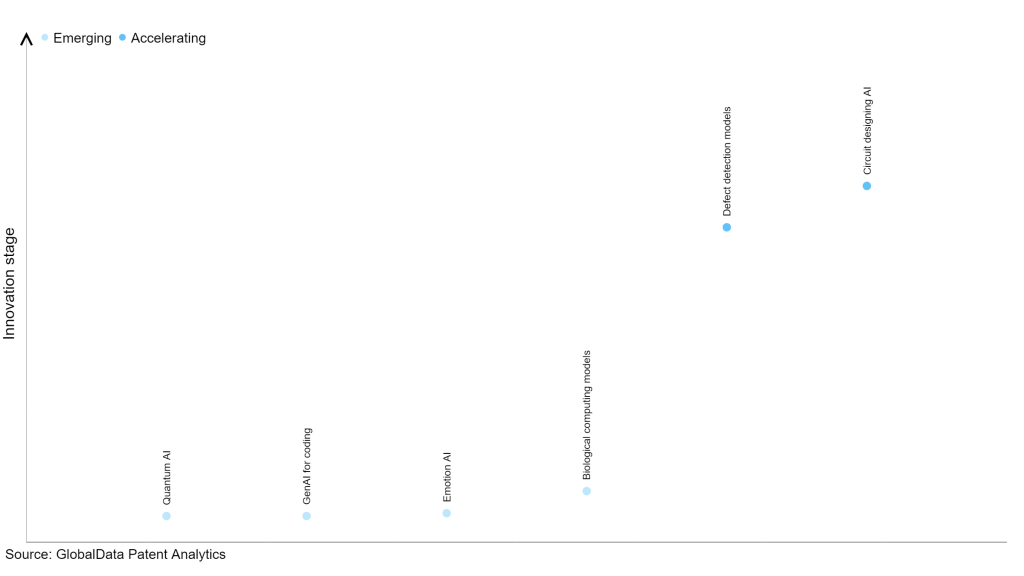The technology industry continues to be a hotbed of patent innovation. Activity is driven by the increasing demand for high-quality imaging in various industries such as healthcare, surveillance, and entertainment, and the growing importance of technologies such as image processing, pattern recognition, and machine learning algorithms that enable efficient and reliable detection and removal of motion artefacts. These technologies contribute to improved image and video analysis, enabling better decision-making and enhancing the overall user experience. In the last three years alone, there have been over 1.5 million patents filed and granted in the technology industry, according to GlobalData’s report on Artificial intelligence in technology: motion artefact analysis. Buy the report here.
However, not all innovations are equal and nor do they follow a constant upward trend. Instead, their evolution takes the form of an S-shaped curve that reflects their typical lifecycle from early emergence to accelerating adoption, before finally stabilizing and reaching maturity.
Identifying where a particular innovation is on this journey, especially those that are in the emerging and accelerating stages, is essential for understanding their current level of adoption and the likely future trajectory and impact they will have.
185+ innovations will shape the technology industry
According to GlobalData’s Technology Foresights, which plots the S-curve for the technology industry using innovation intensity models built on over 1.6 million patents, there are 185+ innovation areas that will shape the future of the industry.
Within the emerging innovation stage, quantum AI, GenAI for coding and emotion AI learning are disruptive technologies that are in the early stages of application and should be tracked closely. Biological computing models, defect detection models, and circuit designing AI are some of the accelerating innovation areas, where adoption has been steadily increasing.
Innovation S-curve for artificial intelligence in the technology industry

Motion artefact analysis is a key innovation area in artificial intelligence
Motion artefact analysis is a method employed to identify and measure distortions caused by movement in imaging data. It is commonly used in medical imaging, like MRI and ultrasound, to evaluate data quality and detect sources of artifacts. The analysis entails comparing measured values to expected values, such as signal intensities or noise levels, in order to identify the presence of motion artefacts. These artefacts may arise from patient motion or external factors beyond control, impacting the accuracy of the imaging results.
GlobalData’s analysis also uncovers the companies at the forefront of each innovation area and assesses the potential reach and impact of their patenting activity across different applications and geographies. According to GlobalData, there are 230 companies, spanning technology vendors, established technology companies, and up-and-coming start-ups engaged in the development and application of motion artefact analysis.
Key players in motion artefact analysis – a disruptive innovation in the technology industry
‘Application diversity’ measures the number of applications identified for each patent. It broadly splits companies into either ‘niche’ or ‘diversified’ innovators.
‘Geographic reach’ refers to the number of countries each patent is registered in. It reflects the breadth of geographic application intended, ranging from ‘global’ to ‘local’.
Patent volumes related to motion artefact analysis
Source: GlobalData Patent Analytics
Heartflow is the leading patent filer in the field of motion artefact analysis.
One of the company’s patents focuses on a system for determining cardiovascular information for a patient, which involves a computer system that receives patient-specific data about the heart's geometry and creates a three-dimensional model of the heart based on this data. Additionally, the computer system generates a physics-based model related to blood flow and calculates the fractional flow reserve within the patient's heart using the three-dimensional model and the physics-based model. Other prominent patent filers in the space include Enlitic and Siemens.
Other prominent patent filers in the space include Cleerly, International Business Machines (IBM), Shanghai United Imaging Healthcare and Koninklijke Philips.
By geographic reach, Enlitic leads the pack, followed by Vektor Medical and Genting Group. In terms of application diversity, Cleerly holds the top position, followed by Siemens and Shanghai United Imaging Healthcare.
Motion artefact analysis refers to the application of artificial intelligence techniques to detect, analyse, and mitigate motion artfacts in digital images or videos. Motion artifacts are distortions or anomalies that occur due to movement during image or video capture, which can degrade the overall quality and affect accurate analysis. AI algorithms, such as deep learning and computer vision, are used to automatically identify and remove these artifacts, resulting in clearer and more accurate visual data.
To further understand how artificial intelligence is disrupting the technology industry, access GlobalData’s latest thematic research report on Artificial Intelligence (AI).
Data Insights
From

The gold standard of business intelligence.
Blending expert knowledge with cutting-edge technology, GlobalData’s unrivalled proprietary data will enable you to decode what’s happening in your market. You can make better informed decisions and gain a future-proof advantage over your competitors.







